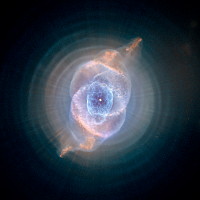It Starts with a Star
A normal star gets its heat from the nuclear fusion of hydrogen, which creates helium as the end product. As the star uses up hydrogen, the more massive helium sinks to the core. The helium cannot fuse in turn because it takes far more energy to get that process going. However, the core of the star becomes more and more compressed as the helium builds up, and eventually, the gravity of the core can create enough energy to get the helium to fuse. Helium fusion creates far more energy than hydrogen fusion—so much energy that it usually destroys the star!
The Star is Destroyed
The extra energy in the core pushes the rest of the star into space leaving the core behind. The core loses most of the pressure that made it fuse, so that process stops, and the core slowly cools off. We call the remaining core a white dwarf, and the expanding ring of debris from the rest of the star is called a planetary nebula. (A planetary nebula has nothing to do with planets except that it is often round.)
A Complex Explosion
Astronomers expected that every planetary nebula would be round, but actually, most are not. Many of them have a series of shells on the outside. These shells are created when the extra fusion in the core stutters—getting started then dying out a few times. Each time, some of the star is pushed away, but then the star pulls itself back together and goes back to normal for a while. The material lost creates one shell. Many planetary nebulae also have an hourglass shape. This is caused by the magnetic field of the star funneling material primarily in two directions. Other planetary nebulae have even more complex and bizarre shapes which we don't yet understand.






